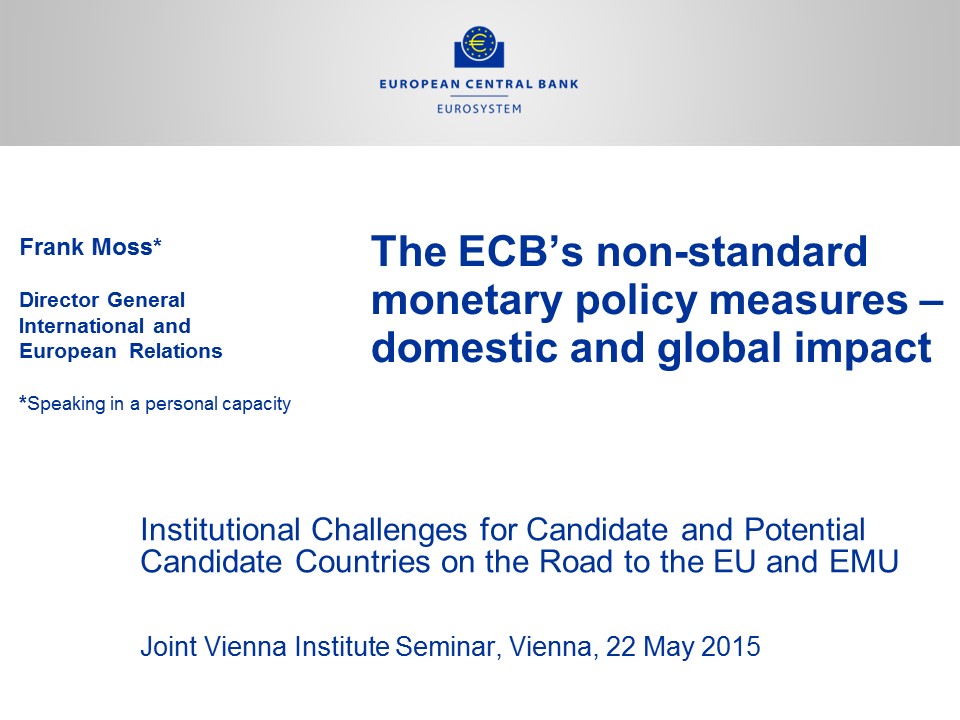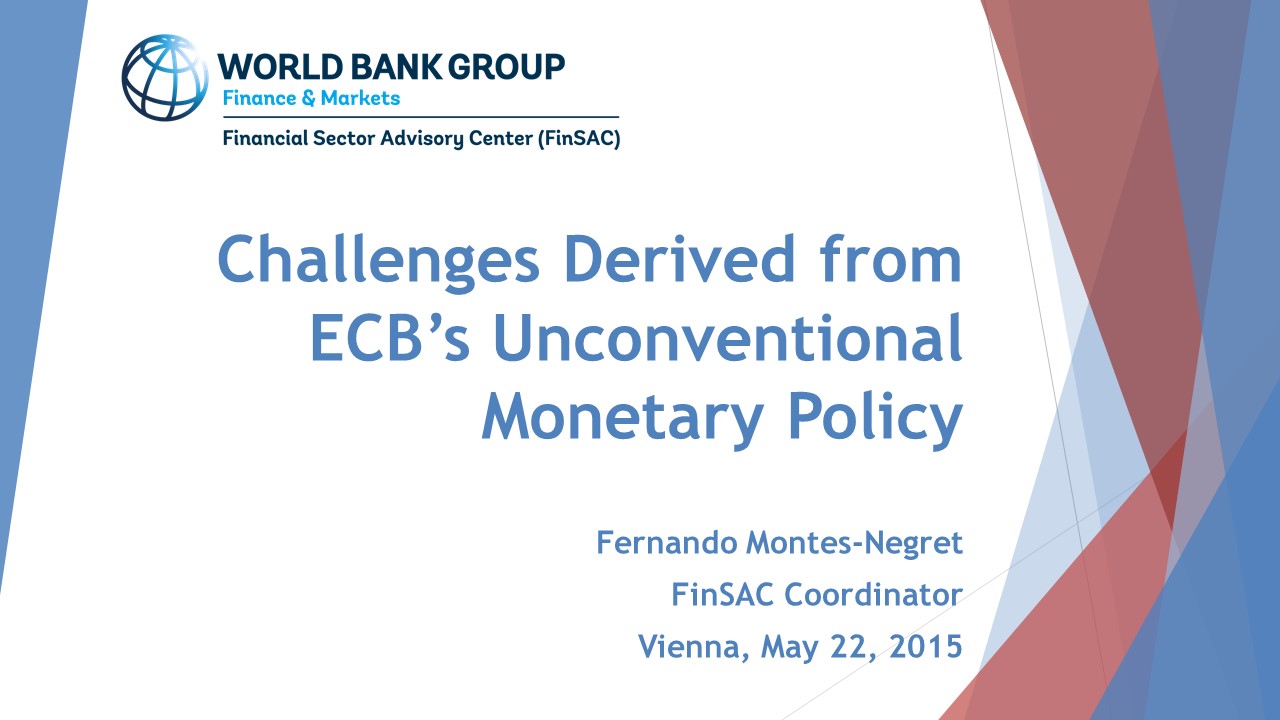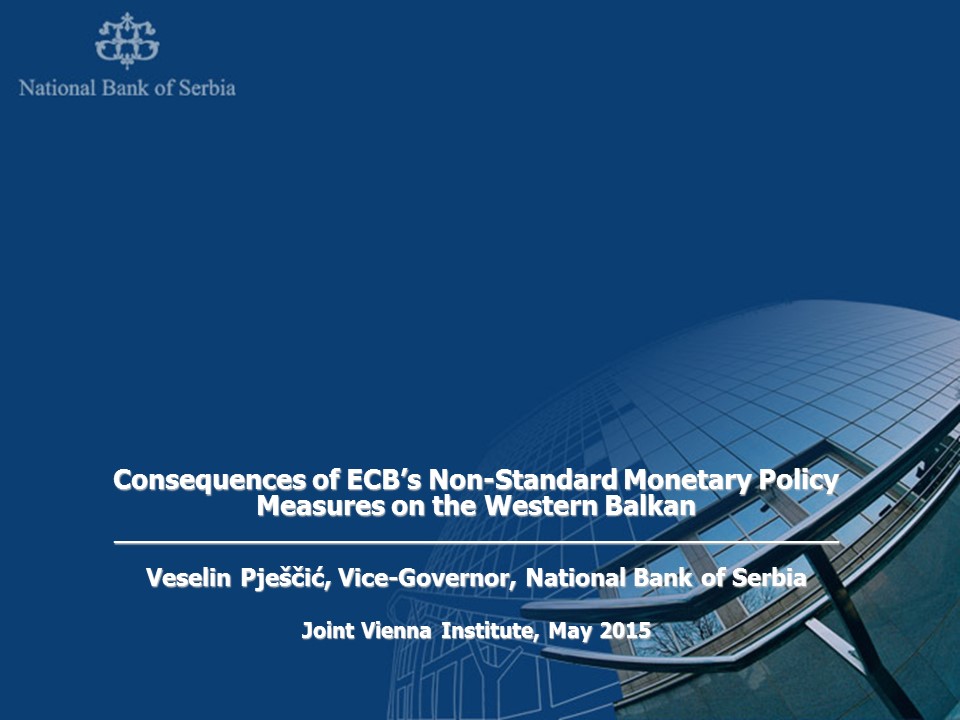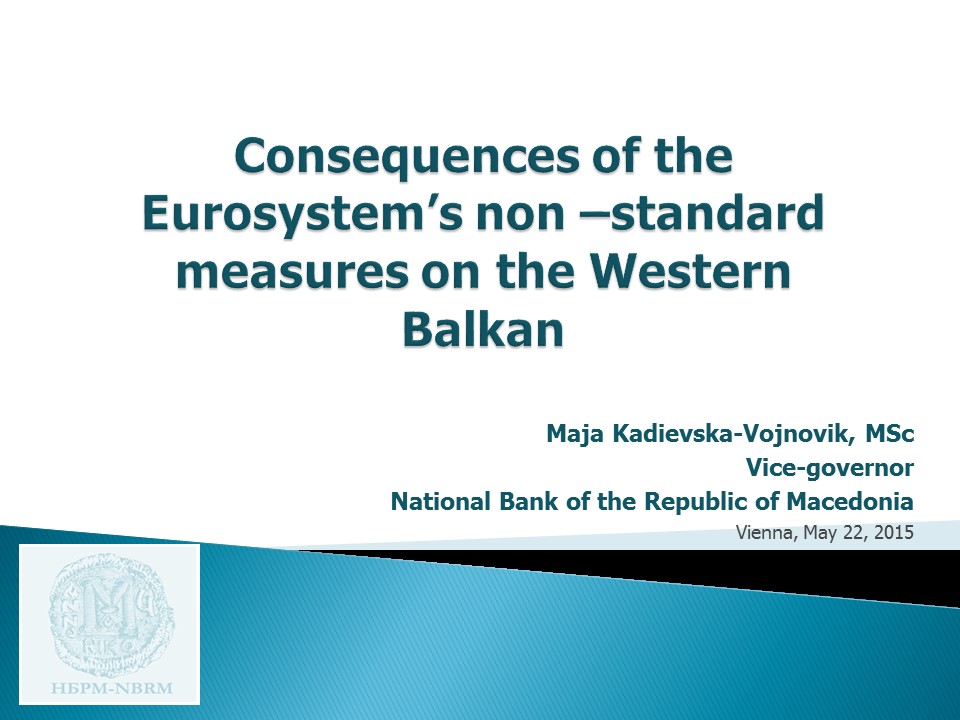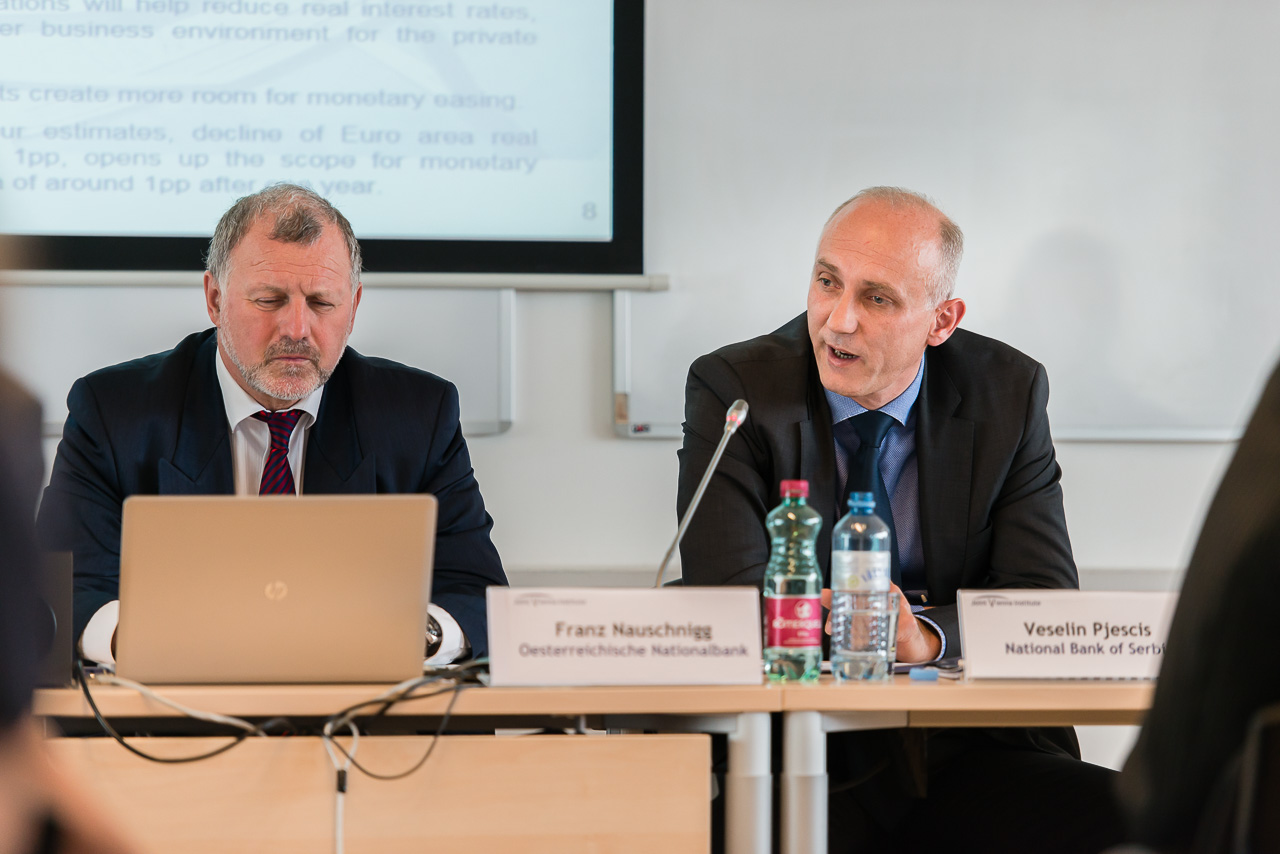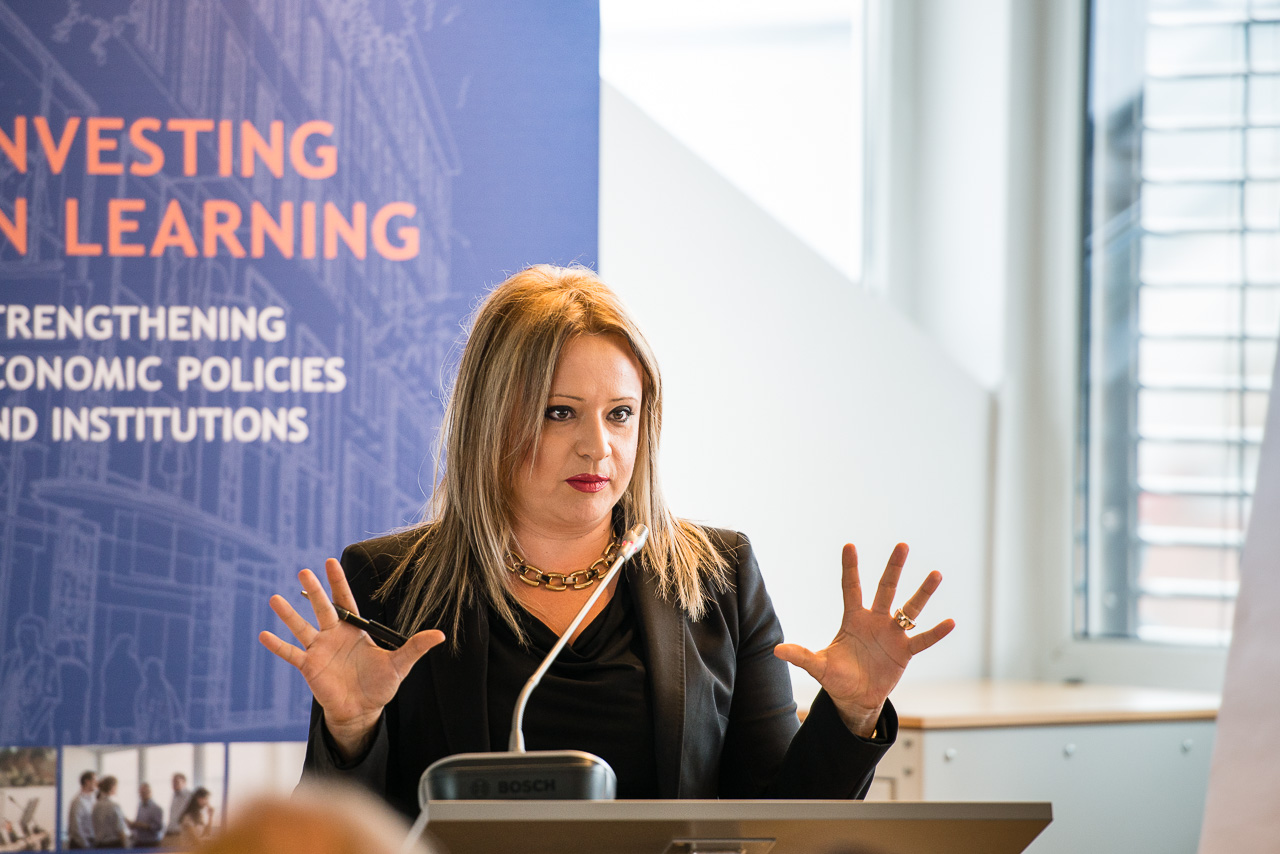Friday, May 22
Keynote Speech
Frank Moss, Director General, European Central Bank
Panelists
Fernando Montes-Negret, World Bank
Veselin Pjescic, Vice-Governor of the National Bank of Serbia
Maja Kadievska Vojnovik, Vice-Governor of the National Bank of the Republic of Macedonia
Chair
Franz Nauschnigg, Head of European Affairs and International Financial Organizations Division, Oesterreichische Nationalbank
Summary
What will be the domestic and global impact of the nonstandard monetary policy measures that the European Central Bank recently introduced? How will the policy affect the euro area’s nearest neighbors—the Western Balkans? These questions were examined in detail at a panel discussion at the JVI on May 22, chaired by Franz Nauschnigg, Head of European Affairs and International Financial Organizations Division, Oesterreichische Nationalbank. Mr. Frank Moss, ECB Director General for International and European Relations, gave the keynote speech. The panel consisted of Maja Kadievska Vojnovik, Vice-Governor, National Bank of the Republic of Macedonia; Fernando Montes-Negret, Head of the Financial Sector Advisory Center, World Bank in Vienna; and Veselin Pjescic, Vice-Governor, National Bank of Serbia.
Mr. Moss outlined the main features of recent ECB monetary policy for the audience, in particular its non-standard measures, and looked at its potential domestic and global impact. The ECB, Mr. Moss noted, had no other choice but to engage in non-standard monetary policy at a time when the medium-term inflation outlook was deteriorating, interest rates had hit their effective lower bound and the transmission from policy to the real economy no longer seemed to be working. The latest instrument employed by the ECB was the quantitative easing (QE) package, in the form of the expanded Asset Purchase Program (APP) to buy euro area government securities. Mr. Moss argued that the new policy had already started to have the intended effect on the domestic economy. Market expectations about the future ECB policy rate have adjusted downward, and inflation expectations seemed to have gone up since April 2015. Furthermore, investors have been rebalancing their portfolios. In 2015, long-term government bond prices have declined in most euro area countries, while equity prices have shot up. At the same time, bank funding costs have decreased, which should ease lending to the real sector. Finally, portfolio rebalancing and the ECB’s policy stance led to a significant depreciation of the nominal effective exchange rate for the euro, which has again eased monetary conditions in the euro area and promoted competitiveness. As a result, the economic growth forecast in 2016 has been revised upwards.
In Mr. Moss’s opinion, the overall global impact of the APP is likely to be positive. The program has already boosted global equity markets by raising investors’ confidence, though the effect on global bond markets remained unclear. Mr. Moss suggested that a more sustained positive impact could include increased appetite for risk in global markets and hence heightened investment, as well as a boost to international trade because of higher demand in the euro area, although he recognized that there was also an increase in the risks to financial stability because of the portfolio rebalancing. Ultimately, he concluded that the impact would depend on each country’s fundamentals in terms of trade and financial linkages with the euro area, the exchange rate regime, the state of structural reforms, and how well the financial market is regulated.
The panel discussed how the ECB’s monetary initiatives are likely to affect euro area neighbors in the Western Balkans.
While acknowledging the necessity of the current ECB policy, Mr. Montes-Negret concentrated on the challenges that it poses, particularly liquidity in the bond markets and medium-term challenges. He identified the threat of resource misallocation when low inflation and low nominal interest rates are prolonged, because that may undermine financial stability and project investment discipline. The risk is particularly important, he said, for the Western Balkans, where non-performing loans are already quite high. He also warned that excessive accumulation of open foreign exchange positions in some countries and in the corporate sector might trigger a vicious circle of capital flight and currency depreciation.
While stating that it is still too early to assess QE effects on Western Balkan countries, Mr. Pjescic also considered the euroization of Western Balkan economies, in particular the balance sheets of their banks, as one of the main challenges the APP poses. He called for countries in the region to build up their macroeconomic fundamentals and increase financial stability to limit the damage from the QE exit by the ECB in the future. At the same time, Mr. Pjescic noted that the APP is likely to have a number of positive spillovers for the Western Balkans and Serbia in particular. Besides helping to stabilize exchange rates and reduce the risk premium, the APP has helped push down interest rates for both the Serbian government and Serbian businesses, opening a channel for credit to the real economy and making public debt more sustainable. He stressed that countries that are carrying out credible fiscal consolidation programs are more likely to feel positive effects from the ECB’s non-standard measures. The Serbian central bank also obtained additional space for easing monetary policy. However, together with other relevant institutions, he emphasized, central banks need to seek improvement in bank balance sheets through the regulatory framework.
Ms. Kadievska Vojnovik was similarly optimistic about the ECB’s current policy. For her, the boost in trade is the most important channel through which the APP will benefit Western Balkan countries, although remittances from the euro area are also expected to rise. She did not expect a dramatic increase in FDI and portfolio investment, because some Western Balkan countries are still facing structural weaknesses in terms of reforming their regulatory environment for doing business. In some countries, the capital markets are still underdeveloped and institutions are not of sufficient quality. The search for yields on the European market resulted in a downward trend in prices of all financial instruments, even for Western Balkan countries, that have already issued Eurobonds at lower costs. However, looking forward, the deteriorating public finances are of concern not only in view of fiscal sustainability and wider economic performance, but also from the point of view of monetary policymaking. Like the other panelists, Ms. Kadievska Vojnovik concluded that keeping their economies stable and undertaking significant structural reforms are the two main conditions if neighboring countries are to benefit from the ECB’s policy.
Questions from the floor were plentiful. The main threads were (a) whether the cure—the ECB’s QE—might be worse than the disease—the buildup of financial stability risks; and (b) what could be done to reduce the negative effects of QE. Mr. Moss’s response was that the objective of the ECB is to avoid entrenching expectations of low inflation, and to buy time for liquidity to spread to the real sector. He admitted that risks to financial stability are likely to build up, especially if the policy continues for a long period. Mr. Montes-Negret added that QE could indeed have many negative side effects, but that the alternatives were worse. Mr. Pjescic and Ms. Kadievska Vojnovik stressed again that macroeconomic stability, structural reforms, and active macro-prudential policies are necessary to harness the benefits of QE and minimize its costs.


